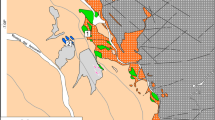Summary
In the Fregeneda area different types of pegmatites can be recognized by their mineralogy, morphology, internal structure and field relationships. The most common type corresponds to a simple pegmatite with homogeneous internal structure, but zoned Li-bearing pegmatites also are relatively widespread. Cassiterite-bearing pegmatites are subordinate. The pegmatites are spatially associated to the Lumbrales granite. This is a parautochthonous, fine- to medium-grained, two-mica granite, one of the syntectonic massifs which were deformed during the third phase of Hercynian deformation. Representative micas selected from the different groups of pegmatites were studied to determine wether the pegmatites can be related by a common fractionation path, and how different pegmatite types are related to the spatially associated Lumbrales granite. Compositional variations in the micas depend on the pegmatite type. Muscovite coexisting with Li-micas in the Li-bearing pegmatites is one of the richest in Al2O3 (35.4–37.7 wt%) and the poorest in FeO (0.2–1.5 wt%) and MgO (0–0.3 wt%), whereas muscovite of the simple discordant pegmatites shows the highest FeO (2.2–3.3 wt%) and that from the Lumbrales granite is the richest in MgO (0.5–0.7 wt%) and TiO2 (0.6–1.1 wt%). On the other hand, Sn (70–1168 ppm), Li (< 5–22253 ppm), F (880–21470 ppm), Cs (< 5–1696 ppm), Rb (800–9181 ppm) and other trace elements seem to increase with distance from the Lumbrales granite, and K/Rb decreases. According to this ratio, the exterior Li-bearing pegmatites are the more evolved, whereas the interior pegmatites are less evolved, and are richer in Cs, Li and Zn than other pegmatite types.
Zusammenfassung
Im Gebiet von Fregeneda sind auf Grund ihrer Mineralogie, Morphologie, Internstruktur und Geländebeziehungen verschiedene Pegmatittypen zu unterscheiden. Am häufigsten sind einfache homogen aufgebaute Pegmatite. Zonar gebaute Li-Pegmatite sind ebenfalls weit verbreitet, Zinnstein-führende Pegmatite treten hingegen zurück, Die Pegmatite sind räumlich mit dem Lumbrales Granit, einem paraautochtonen, fein- bis mittelkörnigen Zwei-Glimmergranit, assoziiert, Dieser gehört einem der syntektonischen Massive, die während der dritten Phase der hercynischen Deformation deformiert wurden, an. Repräsentative, aus den verschiedenen Pegmatittypen separierte Glimmerminerale wurden untersucht, um zu klären, inwieweit die Pegmatite über einen direkten Fraktionierungspfad zu verbinden sind und in welcher Beziehung sie zu dem Lumbrales Granit stehen. Die Variation der Zusammensetzung der Glimmer hängt vom Pegmatittyp ab. Muscovite, die mit Li-Glimmern koexistieren, sind die relativ Al2O3-reichsten (32–37.7 Gew.%) und Fe- (0.2–1.5 Gew.%.) und Mg-ärmsten (0–0.3 Gew.%). Jene aus dem Lumbrales Granit sind die reich an MgO (0.5–0.7) und TiO2 (0.6–1.1 Gew.%). Die Gehalte von Sn (70–1168 ppm), Li (< 5–22253 ppm). F (880-21470 ppm), Cs (< 5–1696 ppm), Rb (800–9181 ppm) und anderer Spurenelemente nehmen mit der Entfernung vom Lumbrales Granit zu, während K/Rb abnimmt. Auf Grund dieses Verhältnisses sind die externen Li-führenden Pegmatite höher, die internen Pegmatite hingegen geringfügiger entwickelt. Erstere sind daher auch reicher an Cs, Li und Zn.
Similar content being viewed by others
References
Appleman DE, Evans HT Jr (1973) US Geol Surv, Comp Contrib 20, US Nat. Tech Inf Serv Doc PB2-16188
Bailey SW (1980) Structures of layer silicates. In:Brindley GW, Brown G (eds) Crystal structures of clay minerals and their X-ray identification, chapter l. Mineralogical Society, London
Bea F, Sánchez JG, Serrano Pinto M (1988) Una compilación geoquimica para los granitoides del macizo Hespérico. In: Geología de los granitoides y rocas asociadas del macizo Hespérico. Edit Rueda, 87–192
Carnicero MA (1981) Granitoides del Centro Oeste de la Provincia de Salamanca. Clasificación y correlación. Cuadernos Laboratorio Xeolóxico de Laxe 2: 45–49
—— (1982) Estudio del metamorfismo existente en torno al granito de Lumbrales (Salamanca). Studia Geologica Salmanticensia 17: 7–20
Černý P (1982) Short course in granitic pegmatites in science and industry. Petrogenesis of granitic pegmatites. In: MAC Short Course Handbook, vol 8, pp 405–461
—— (1984) Paragenesis, crystallochemical characteristics, and geochemical evolution of micas in granite pegmatites. Rev Mineral 13: 257–297
Foster MD (1960) Interpretation of the composition of Li-micas. US Geol Survey Prof Paper 354 E, M.A. 15–263
Garcia Garzón J, Locutura J (1981) Datación por et método Rb-Sr de los granitos de Lumbrales-Sobradillo y Villar de Ciervo-Puerto Seguro. Bol Geol y Min de Esp 92-1: 68–72
Jolliff BL, Papike JJ, Shearer CK (1992) Petrogenesic relationships between pegmatite and granite based on geochemistry of muscovite in pegmatite wall zones, Black Hills, South Dakota, USA. Geochim Cosmochim Acta 56:1915–1939
López Plaza M, Carnicero MA (1988) El plutonismo Hercinico de la penillanura salmantinozamorana(centro-oeste de España): Visión de conjunto en et contexto geológico regional. In: Geologia de los granitoides y rocas asociadas del macizo Hespérico. Edit Rueda, 53–68
López Plaza M, Carnicero A, Gonzalo JC (1982) Estudio geológico del campo filoniano de La Fregeneda (Salamanca). Studia Geologica Salmanticensia XVII: 89–98
López Plaza M, Martinez Catalán JR (1988) Sintesis estructural de los granitoides Hercinicos del macizo Hespérico. In: Geologia de los granitoides y rocas asociadas del macizo Hespérico. Edit Rueda, 195–210
Martinez Fernandez FJ (1974) Estudio del área metamórfica y granitica de los Arribes del Duero (Prov. de Salamanca y Zamora). Thesis, Salamanca University
Norton JJ (1973) Lithium, cesium and rubidium-the rare alkali metals. United States Mineral Resources [Brobst DA, Pratt WP (eds)]. US Geo Surv Prof Pap 820: 365–378
Roda E, Pesquera A, Velasco F (1991) The pegmatites of the Fregeneda area, Salamanca, Spain. In:Pagel M, Leroy JL (eds) Source, transport and deposition of metals. Balkema, Rotterdam, pp 801–806
Smeds SA (1992) Trace elements in potassium-feldspar and muscovite as a guide in the prospecting for lithium- and tin-bearing pegmatites in Sweden. Geoch Explor 42: 351–369
Stewart DB (1978) Petrogenesis of lithium-rich pegmatites. Am Mineral 63: 970–980
Author information
Authors and Affiliations
Additional information
With 4 Figures
Rights and permissions
About this article
Cite this article
Roda Robles, E., Pesquera Peréz, A. & Velasco Roldán, F. Micas of the muscovite-lepidolite series from the fregeneda pegmatites (Salamanca, Spain). Mineralogy and Petrology 55, 145–157 (1995). https://doi.org/10.1007/BF01162585
Received:
Accepted:
Issue Date:
DOI: https://doi.org/10.1007/BF01162585




